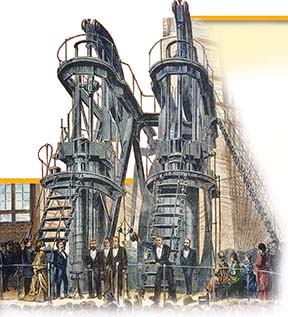SECTION 1: Technology and Industrial Growth

◄ President Grant and foreign visitors look in amazement at the Corliss steam engine, shown for the first time at the Centennial.

Alexander Graham Bell’s telephone ►
WITNESS HISTORY  AUDIO
AUDIO
Celebrating the Nation’s Centennial
On May 10, 1876, the United States celebrated its 100th anniversary by opening the Centennial Exhibition in Philadelphia. At a time when the total population of the country was only 46 million people, the exhibition drew nearly 9 million visitors. The event stunned Americans and foreign visitors alike with its demonstration of new technology, including an icemaker and a telephone. It also introduced the United States to the world as a new industrial and innovative powerhouse.
Objectives
- Analyze the factors that led to the industrialization of the United States in the late 1800s.
- Explain how new inventions and innovations changed Americans’ lives.
- Describe the impact of industrialization in the late 1800s.
Terms and People
- entrepreneur
- protective tariff
- laissez faire
- patent
- Thomas Edison
- Bessemer process
- suspension bridge
- time zone
- mass production
NoteTaking
Reading Skill: Identify Causes and Effects As you read, record the causes and effects of industrialization in a chart like the one below.

Why It Matters The end of the Civil War marked the beginning of a major transformation in American society. Americans enthusiastically embraced innovation and technology with the goals of expanding business and improving people’s daily lives. American industrialization grew out of the English Industrial Revolution, but it had a distinctly American character. Backed by business leaders and shaped by a huge number of creative inventors and scientists, this “second industrial revolution” turned the United States into an industrial powerhouse. Section Focus Question: How did industrialization and new technology affect the economy and society?
Encouraging Industrial Growth
The Civil War challenged industries to make products more quickly and efficiently than they had been made before. Factories stepped up production, employing new tools and methods to produce guns, ammunition, medical supplies, and uniforms in large numbers. The food industry transformed itself, developing ways to process foods so they could be shipped long distances. Railroads expanded, and more efficient methods of creating power were developed. Meanwhile, the government encouraged immigration to meet the increasing demand for labor in the nation’s factories.
Natural Resources Fuel Growth
The country’s growth was fueled, in part, by its vast supply of natural resources. Numerous




